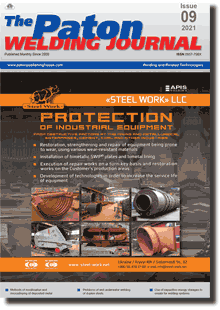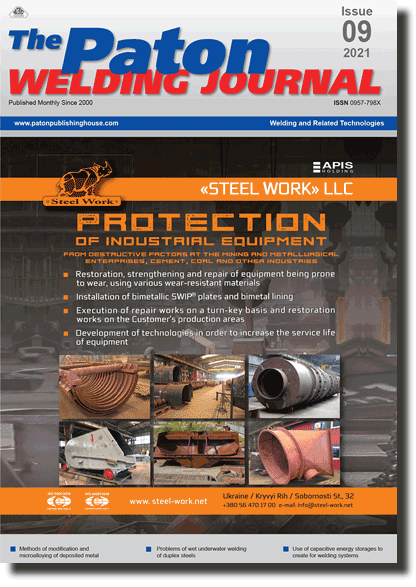Access for download PDF files for subscribers and for reviewers of scientometric bases.
Organization: Elsevier for content access(PDF files of journals released before 2024 are available for download from the website's archives))
Organization: Elsevier for content access(PDF files of journals released before 2024 are available for download from the website's archives))
| 2021 №09 (04) |
DOI of Article 10.37434/tpwj2021.09.05 |
2021 №09 (06) |

The Paton Welding Journal, 2021, #9, 27-38 pages
Modeling of the process of induction heat treatment of welded joints from rail high-strength steels
R.S. Hubatyuk, S.V. Rymar, O.S. Prokofiev, V.A. Kostin, O.V. Didkovskyi and E.V. Antipin
E.O. Paton Electric Welding Institute of the NASU. 11 Kazymyr Malevych Str., 03150, Kyiv, Ukraine. E-mail: office@paton.kiev.ua
Abstract
The selection of technological parameters of the heat treatment process, which provides the necessary structural and phase transformations of rail welded joint, is a very expensive process that requires a large number of experiments with a significant consumption of power, time, labor and financial resources. The paper proposes the method of mathematical and physical modeling of thermal processes to determine the optimal parameters of heat treatment of rail welded joint on model specimens based on the theory of similarity, taking into account the interrelated properties and physical phenomena with the original study. The solutions obtained during realization of this method provide a considerable reduction of resources at determination of optimum modes of heating of products from high-strength carbon steels, in particular, rails. Based on the scale factors of criteria of electromagnetic and thermal similarity, a mathematical model of the induction system for numerical calculation of propagation of electromagnetic and thermal fields was developed. The finite element method was used, which represents a tool for combining integral characteristics with the values of vector characteristics of the studied electromagnetic fields. The dependence of physical properties of materials on temperature was taken into account. In the course of parametric study, the parameters and configuration of the «inductor– product» system were determined and the space-time distribution of the temperature field during heat treatment modeling was determined. The obtained data of numerical calculation should be used during physical modeling of optimization of the modes of heat treatment of the sample and will significantly reduce the number of experiments to determine the effect of thermal heating on phase transformations and mechanical properties of steel in the zone of welded joint. 18 Ref., 2 Tables, 9 Figures.
Keywords: induction heating, heat treatment, welded joint of railway rails, mathematical modeling, similarity theory
Received 12.07.2021
References
1. Gubatyuk, R.S. (2019) Heat treatment of welded joints of high-strength railway rails (Review). The Paton Welding J., 2, 41-48. https://doi.org/10.15407/tpwj2019.02.072. Kuchuk-Yatsenko, S.I., Antipin, E.V., Didkovskyi, O.V. et al. (2020) Evaluation of quality of welded joints of highstrength railway rails of modern production taking into account the requirements of ukrainian and european standards. Ibid., 7, 3-11. https://doi.org/10.37434/tpwj2020.07.01
3. Rezanov, V.A., Fedin, V.M., Bashlykov, A.V. (2013) Differentiated hardening of rail welded joints. Vestnik VNIIZhT, 2, 28-34 [in Russian].
4. Dolgikh, I.Yu., Korolyov, A.N., Zakharov, V.M. (2014) Simulation of thermal processes dynamics under induction heating. Vestnik ISEU, 5, 1-7 [in Russian].
5. Pleshivtseva, Yu. E., Popov, A. V., Popova, M. A., Derevyanov, M. Yu. (2019) Optimal inductor design for surface hardening of cylindrical billets based on numerical two-dimensional model. Vestnik of Astrakhan State Technical University. Series: Management, Computer Science and Informatics, 1, 40-50. https://doi.org/10.24143/2072-9502-2019-1-40-50
6. Chao, Yu, Hong, Xiao, Zi-chen, Qi, Yun-peng, Zhao (2019) Finite element analysis and experiment on induction heating process of slab continuous casting-direct rolling. Metallurgical Research & Technology, 116 (4), 403. https://doi.org/10.1051/metal/2018117
7. Li, F., Ning, J., Liang, S. (2019) Analytical modeling of the temperature using uniform moving heat source in planar induction heating process. Applied Sci., 9, 14-45. https://doi.org/10.3390/app9071445
8. Takeuchi, H., Yogo, Y. (2019) An induction heating analysis with consideration of temperature dependent B-H curves and change in phase transformation under rapid heating. ISIJ Int., 59, 551- 558. https://doi.org/10.2355/isijinternational.ISIJINT-2018-552
9. Javaheri, V., Asperheim, J.I., Grande, B. et al. (2020) Simulation and experimental studies of induction hardening behavior of a new medium-carbon, low-alloy wear resistance steel. COMPEL - the international journal for computation and mathematics in electrical and electronic engineering, 39 (1), 158-165. https://doi.org/10.1108/COMPEL-06-2019-0227
10. Gubatyuk, R.S., Rymar, S.V., Prokofiev, O.S. et al. (2021) Simulation of electromagnetic and thermal fields in the process of induction heating on small specimens with the presence of welded joint of high-strength railway rails. The Paton Welding J., 1, 44-49. https://doi.org/10.37434/as2021.01.08
11. Roppert, K., Toth, F., Kaltenbacher, M. (2020) Modeling nonlinear steady-state induction heating processes. IEEE Transact. on Magnetics, 56 (3). https://doi.org/10.1109/TMAG.2019.2957343
12. Venikov, V.A. (1966) Similarity theory and modeling as applied to the problems of the electric power industry. Moscow, Vysshaya Shkola [in Russian].
13. Paton, B.E., Lebedev, V.K. (1969) Electrical equipment for resistance welding. Moscow, Mashinostroenie [in Russian].
14. Pentegov, I.V., Rymar, S.V., Levin, M.I., Lavrenyuk, A.V. (2015) Determination of magnetic inductions in the magnetic circuits of power transformers with the combined use of anisotropic and isotropic electrical steels. Elektrotekhnika i Elektromekhanika, 6, 31-35 [in Russian]. https://doi.org/10.20998/2074-272X.2015.6.05
15. Kutateladze, S.S. (1982) Similarity analysis in thermal physics. Novosibirsk, Nauka [in Russian].
16. Landau, L.D., Lifshits, E.M. (2006) Field theory. Theoretical physics. Moscow, Fizmatlit [in Russian].
17. Pentelyat, M.G., Shulzhenko, N.G. (2007) Use of vector magnetic potential in finite element analysis of non-stationary three-dimensional electromagnetic fields in conducting media. Elektrotekhnika i Elektromekhanika, 5, 42-47 [in Russian].
18. Vladimirov, S.N., Zeman, S.K., Ruban, V.V. (2009) Analytical relations approximating the temperature-field dependence of the magnetic permeability of structural steels. Izv. TPU, 315(4), 100-104 [in Russian].
Suggested Citation
R.S. Hubatyuk, S.V. Rymar, O.S. Prokofiev, V.A. Kostin, O.V. Didkovskyi and E.V. Antipin (2021) Modeling of the process of induction heat treatment of welded joints from rail high-strength steels. The Paton Welding J., 09, 27-38.The cost of subscription/purchase order journals or individual articles
| Journal/Currency | Annual Set | 1 issue printed |
1 issue |
one article |
| TPWJ/USD | 384 $ | 32 $ | 26 $ | 13 $ |
| TPWJ/EUR | 348 € | 29 € | 24 € | 12 € |
| TPWJ/UAH | 7200 UAH | 600 UAH | 600 UAH | 280 UAH |
| AS/UAH | 1800 UAH | 300 UAH | 300 UAH | 150 UAH |
| AS/USD | 192 $ | 32 $ | 26 $ | 13 $ |
| AS/EUR | 180 € | 30 € | 25 € | 12 € |
| SEM/UAH | 1200 UAH | 300 UAH | 300 UAH | 150 UAH |
| SEM/USD | 128 $ | 32 $ | 26 $ | 13 $ |
| SEM/EUR | 120 € | 30 € | 25 € | 12 € |
| TDNK/UAH | 1200 UAH | 300 UAH | 300 UAH | 150 UAH |
| TDNK/USD | 128 $ | 32 $ | 26 $ | 13 $ |
| TDNK/EUR | 120 € | 30 € | 25 € | 15 € |
AS = «Automatic Welding» - 6 issues per year;
TPWJ = «PATON WELDING JOURNAL» - 12 issues per year;
SEM = «Electrometallurgy Today» - 4 issues per year;
TDNK = «Technical Diagnostics and Non-Destructive Testing» - 4 issues per year.


